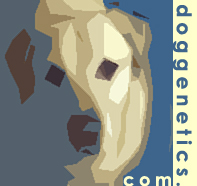
Genetic Improvement of Explosive Detection Canines
Liz Hare, PhD
LizHare@DogGenetics.com
The TSA Canine Breeding and Development Center breeds dogs to work as explosives detectors and prepares them for training. As the program grows in size, it will be possible to improve the work-related behavior traits, health characteristics, and olfaction by selective breeding. This project combines well-established quantitative genetics methods with advanced genomics research to improve the success rates of this canine population.
Quantitative genetics methods will be used to determine the heritabilities of behavior and health traits, facilitating the prediction of results from selection and assisting in the prioritization of characteristics for selection. Behavior traits to be analyzed include traits related to retrieving, such as chase-retrieve effectiveness, and personality and developmental traits to be measured in a concurrent study of this population. Calculation of estimated breeding values (EBV) will result in a ranking of dogs according to their genetic and phenotypic values for traits of interest.
In the genomics portion of the study, each dog in the population will be genotyped at 20,000 single nucleotide polymorphisms (SNP) on the Illumina Canine20 array, and 1500 SNPs selected for their relevance to behavior, learning and olfaction. Linkage analysis will be used to determine whether specific regions of the genome are associated with variation in these traits. Markers significantly associated with important traits will be incorporated into selective breeding decisions for the improvement of future generations. In addition, a set of markers within genes important for learning, work-related behavior, and olfaction will be analyzed.
Recently, there has been great interest in epigenetic factors that affect the expression of genes, particularly methylation, which often blocks the promoter regions of genes, downregulating their expression. A whole-genome assay of methylation of promoter regions will be carried out with the goal of finding variations in methylation patterns that are associated with the development of phenotypes of interest.
The quantitative genetics, genomic, and epigenetics knowledge gathered in this study will be used with selective breeding to improve behavior and health characteristics in the TSA population incrementally with each successive generation. Data will be combined using mathematical expressions which reflect breeding values as well as relative weights of each trait, providing an objective strategy for improving the success rates of dogs and efficiency of the overall breeding program over time.